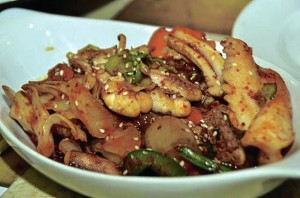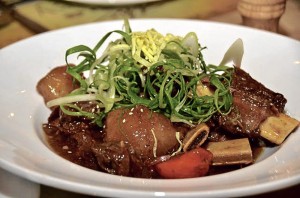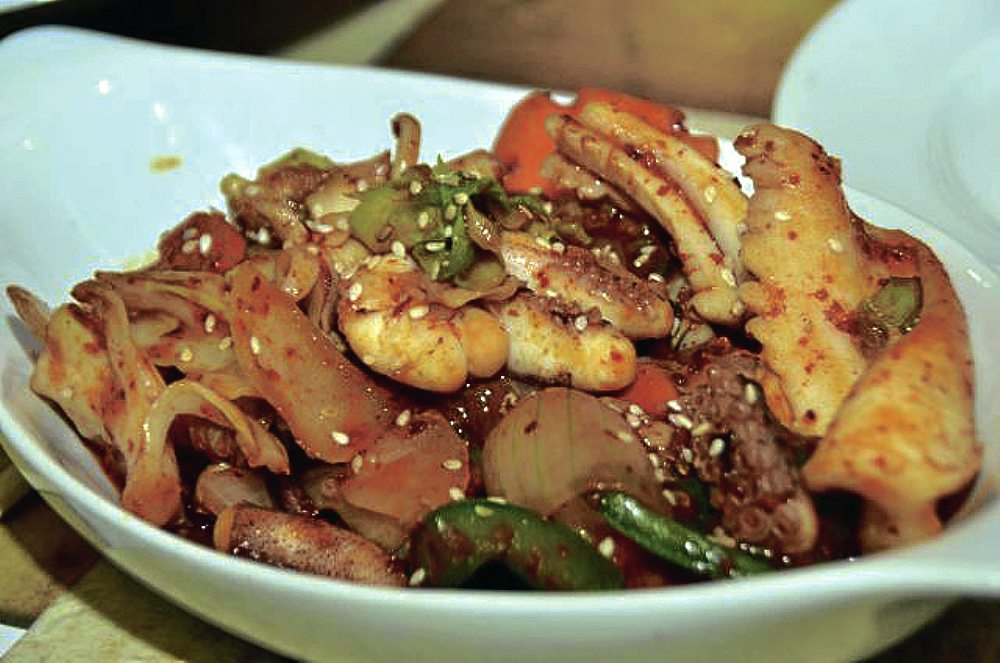
It’s a general observation by diners that Korean restaurants are so generous, because staff bring out several small dishes as soon as you sit down. Because of that, diners comment that sometimes those dishes are enough to make one full. But what is perceived as appetizers are really side dishes for the main course.
In the book “Practical Korean Cooking” by Noh Chin-hwa (Hollym Corporation, 1985), those side dishes are part of the Korean table setting. And the classification of the number of side dishes is signified by the word “chop.”
If the table setting is called three-chop, it means there are three side dishes to accompany the main course/s, together with the rice, soup and kimchi. One of my dining experiences in Korea had probably a nine-chop setting, because almost the whole table was filled with these small bowls as soon as we entered a restaurant that specialized in traditional food.
At a preview of at the Korean Food Festival at the InterContinental Manila, the chop included just the pickled spinach (sigeumchi namul). There were three kinds of kimchi (white, radish and spicy pickled cabbage). And then a succession of dishes crowded our table.
Those that were familiar were the haemul pageon, an omelet of seafood and spring onions, as well as japchae, made of potato noodles flavored with soy and topped with vegetables. Modum jeon was a first encounter—almost like pageon because it consists of assorted pancakes made from different ingredients such as fish, kimchi, zucchini and tofu.
Warming effect
Soup was kalbi tang, the Korean version of the Filipino bulalo. The presentation, though, is neater than the kneecap-and-beef shin of our bulalo. It was kalbi tang that kept me warm during my first visit to Korea, served in night markets that stayed open until dawn. The warming effect is important in the country that has cold weather most months of the year.

Many homes and restaurants have their floors heated, which helps to keep off the cold but doesn’t stop your legs from sleeping from sitting on them for more than hour.
Beef barbecue (yang yeow kalbi) came soon after, served by itself without the accompanying leaves and sauces that we experienced in restaurants here. The cut of the beef defines it as Korean, because several thin slices are still attached to the bone. Many of the Korean groceries sell this kind of cut—recommended if you want to cook this dish.
And because meat dominates the Korean table, there was also galbi-chim, beef stew that served as my introduction to the cooking and is still my favorite. Naturally, we looked for rice that a stew needs, but it came as part of the bibimbap, rice topped with vegetables, meat and chili sauce. This isn’t a particular favorite of mine, but it is with my children, especially when served from a heated bowl.
The only seafood dish that day was stir-fried squid, red with chili. In Korea, we were told that very few restaurants serve seafood because it is expensive, but octopus is favored by most diners.
Rice cakes
No dessert was served, which made our table wonder if there is such a thing as Korean dessert. The same cookbook mentioned above listed several rice cakes like our kakanin, candied vegetables, sesame cakes, honey-coated pear.
Someone mentioned the sweet rice drink (shik ye) made of glutinous rice rendered sweet with malt powder and boiled in water, sugar and pine nuts.
The promotional leaflet said that during the festival (done together with ARA Restaurant based in Makati), there will be free-flowing persimmon punch (sujeonggwa) for the guests. Maybe this sweet concoction will appease the sweet tooth.
But for our sweet tooth that day, we repaired to the dessert buffet made mainly of Western cakes and pies, plus the halo-halo of the Café Jeepney where this festival will be held until May 27. (For reservations, call 793-7000.)
Sam Leong, the modern Chinese chef from Singapore who with his wife, Forest, entertained many foodies last year, will be back on May 24-25.
He will conduct a cooking demo with lunch and will cook for a degustation dinner with wine pairing. (Call Makati Shangri-La at 8138888).
E-mail the author at [email protected]









































